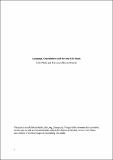Files in this item
Language, entanglement and the new Silk Roads
Item metadata
| dc.contributor.author | Fierke, K. M. | |
| dc.contributor.author | Antonio-Alfonso, Francisco | |
| dc.date.accessioned | 2018-04-13T16:30:07Z | |
| dc.date.available | 2018-04-13T16:30:07Z | |
| dc.date.issued | 2018-09-01 | |
| dc.identifier | 252028606 | |
| dc.identifier | d4fc79c3-54ac-4e34-a4f9-f4b5e0b7c11f | |
| dc.identifier | 85052697463 | |
| dc.identifier | 000445767400002 | |
| dc.identifier.citation | Fierke , K M & Antonio-Alfonso , F 2018 , ' Language, entanglement and the new Silk Roads ' , Asian Journal of Comparative Politics , vol. 3 , no. 3 , pp. 194-206 . https://doi.org/10.1177/2057891118762521 | en |
| dc.identifier.issn | 2057-892X | |
| dc.identifier.uri | https://hdl.handle.net/10023/13133 | |
| dc.description.abstract | Observers have tended to place the Silk Road proposals in the context of ‘China’s rise’, and its increasing influence and interests in Central, South and South-East Asia. From a realist perspective, China, like any expanding state, poses a potential threat. From a liberal angle, it is expanding the space for cooperation. Both models rely on an individualist ontology that highlights the interests of individual states. The potential of the Silk Roads looks somewhat different if approached from the perspective of a more relational ontology and a concept of entanglement. We draw on a few claims from Alexander Wendt’s (2015) recent book as a framework for examining the emerging reality of the new ‘Silk Roads’. What are the implications of this ontological shift for thinking about the Chinese ‘Silk Road’ proposal? We develop three specific claims as part of a reflection on this context: first, language use is a form of measurement that shapes and transforms reality; second, language use is an expression of entanglement; and third, leaders have a large role in ‘collapsing wave functions’ around specific potentials. While some of the themes that arise in this discussion are compatible with other arguments about the role of language, the quantum angle provides a more explicit point of departure for discussing the ‘physical’ dimensions of language use, the multiple layers of meaning within which the OBOR is embedded and its relational ontology. | |
| dc.format.extent | 20 | |
| dc.format.extent | 360251 | |
| dc.language.iso | eng | |
| dc.relation.ispartof | Asian Journal of Comparative Politics | en |
| dc.subject | Entanglement | en |
| dc.subject | Language | en |
| dc.subject | OBOR | en |
| dc.subject | Silk Road | en |
| dc.subject | Wendt | en |
| dc.subject | B Philosophy (General) | en |
| dc.subject | JZ International relations | en |
| dc.subject | T-NDAS | en |
| dc.subject.lcc | B1 | en |
| dc.subject.lcc | JZ | en |
| dc.title | Language, entanglement and the new Silk Roads | en |
| dc.type | Journal article | en |
| dc.contributor.institution | University of St Andrews. School of International Relations | en |
| dc.identifier.doi | 10.1177/2057891118762521 | |
| dc.description.status | Peer reviewed | en |
| dc.date.embargoedUntil | 2018-03-15 |
This item appears in the following Collection(s)
Items in the St Andrews Research Repository are protected by copyright, with all rights reserved, unless otherwise indicated.

